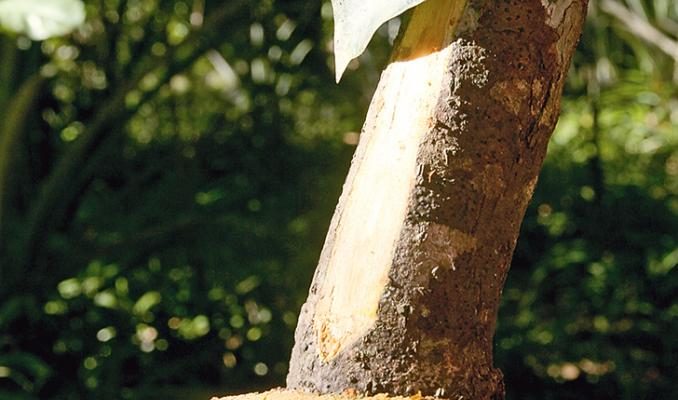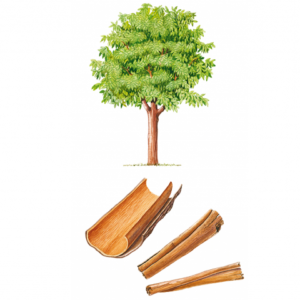
Find out more about the Ceylon Cinnamon plant of our Aromatherapy Herbarium blog series.

CEYLON CINNAMON
Cinnamomum verum
DESCRIPTION

Do not use pure, always combined with other essential oils.
“True” cinnamon is an evergreen tree which may reach fifteen meters.
ADVICE
Essential oil of cinnamon bark is used preferably by oral route with a liver protector. For cooking, one or two drops of essential oil are enough to perfume a dish for five to six persons.
DO NOT USE IN
– pregnant or breast-feeding women,
– children under the age of twelve years,
– subjects with epilepsy,
– persons with a history of gastro-oesophageal reflux, gastritis or gastroduodenal ulcer, hepatitis, B, C or D,
– persons allergic to one of the components (cinnamic aldehyde, benzyl benzoate, eugenol, limonene, linalool),
– subjects with asthma.
RECIPES
Diarrhoea (pains)
Mix 2 drops of essential oil of cinnamon bark in 10 drops of neutral carrier oil. Massage the stomach and abdomen after meals. You may also take 2 drops of essential oil of cinnamon (or recipe below) on a neutral tablet, sugar lump or in a spoonful of honey.
Infectious diarrhoea (turista),
prevention or cure
1 drop of EO of cinnamon bark, 1 drop of EO of niaouli.
- For prevention, take the essential oils on a neutral tablet in the morning twenty four hours before departure, during the stay and forty eight hours after return.
- Curative treatment: take this mixture three times daily until the symptoms disappear.
Physical or Psychical Fatigue
1 drop of EO of cinnamon bark, 1 drop of EO of ravintsara.
Take 1 drop of each of the essential oils three times daily on a neutral tablet, do not exceed two weeks.
Urinary Infection
1 drop of EO of cinnamon bark, 1 drop of EO of lemon.
Take 1 drop of each of the essential oils on a neutral tablet three times daily over seven days. To prevent recurrence, take 1 drop of tea tree each morning on a neutral tablet, one week per month for three months.

Native of Sri Lanka, it is a member of the Laureaceae family. Its leaves are long and shiny; its small round flowers give dark blue berries.
Cinnamon, with myrrh, is one of the spices that the Book of Kings reserves for the perfume of the Great Priest and the Ark. The Lord says: “Take eight hundred shekels of cinnamon. You will prepare a holy anointing oil, a fragrant mixture as the one the perfume makers composes. “Cinnamon came from India, where the Greeks had founded a factory, not far from the actual city of Karachi. The bark from young cinnamon tree shoots were removed every two years. It curled on itself on drying, forming cylinders. The spice was exported in chips, powder or small canes, which gave the tree its French name. “A root and leave which are highly prized in India. They have a burning taste and a superb smell. The rest of the plant is useless”, wrote Pliny in his Natural history. The Greeks and Romans mainly used it as an aphrodisiac and incidentally as a disinfectant. Like many spices, cinnamon appears in France with the returning crusaders. It perfumes, along with ginger, the sweet wine called “Hypocras”. In cooking, its delicate, spicy and sweet flavour is found in numerous recipes, from gingerbread to rice pudding.
CULTIVATION AND PRODUCTION
The tree was only cultivated from the 13th century onwards. Only Sri Lanka and Madagascar produce Cinnamomum zeylanicum or Cinnamomum verum.
FRAGRANCE
The odour of cinnamon bark is unique, warm, spicy and sweet at the same time, penetrating and powerful with a light “burnt” note.
EXTRACTION AND YIELD
The bark, harvested during the rainy season, yields 0.4% to 1.7% of essential oil by water distillation, i.e. four hundred grams to a seventeen hundred grams per hundred kilograms of plant.
CHEMICAL FORMULA
The composition of essential oil of cinnamon bark is complex. Its principal components are cinnamic aldehyde (72% to 80%) and eugenol (approximately 10%), the proportion reverses in the case of essential oil extracted from leaves and not bark.
MAIN INDICATIONS
Essential oil of cinnamon bark is an antiseptic, antiviral and antibacterial agent with a wide action spectrum. It kills even micro-organisms that are resistant to antibiotics. It is used against all infections, be they respiratory (bronchitis, cold, flu), intestinal (gastroenteritis or traveller’s diarrhoea contracted while travelling in a warm country), urinary (cystitis) or gynaecological. It stimulates cardiac and respiratory functions. It is a good physical and psychical tonic. Cinnamon powder is in the fourth position of antioxidant rich foods.


Leave a Comment